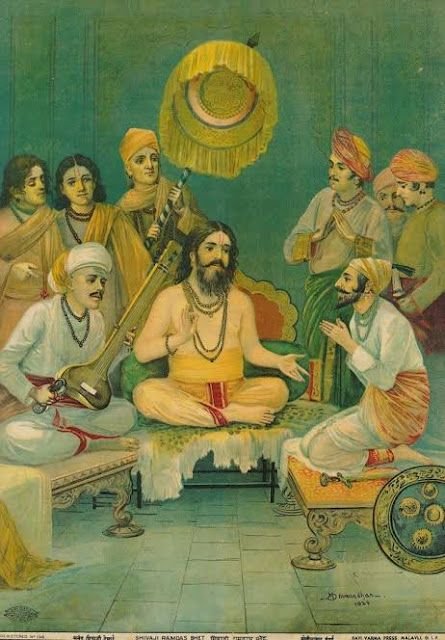Samarth Ramdas: The Guiding Light of Devotion

Samarth Ramdas, also known as Ramdas Swami, emerges from the annals of history as a beacon of unwavering faith and spiritual wisdom. His life, teachings, and remarkable achievements continue to inspire generations. Let us delve into the essence of this revered saint. Born as Narayan Suryajipant Thosar around 1608 CE in the village of Jamb, Maharashtra, Ramdas was destined for a life of devotion. His father’s early demise marked the beginning of his spiritual journey. Fleeing his own wedding ceremony upon hearing the word “Beware!” During a Hindu ritual, young Narayan embarked on a pilgrimage along the Godavari river. His ascetic years at Takhli near Nashik were marked by rigorous meditation and unwavering devotion to Lord Rama.

Ramdas’s literary works resonate with timeless wisdom:
Dasbodh: A spiritual treatise that delves into the essence of life, morality, and devotion.
Manache Shlok: A collection of 205 verses that guide seekers toward self-realisation.
Aatmaram: A philosophical work emphasising detachment and inner peace.
Manobodh: A practical guide to righteous living and ethical conduct.
In 1644 CE, Ramdas initiated the Ramdasi Sampradaya by installing the idol of Lord Maruti at Shahapur, Satara. This movement emphasised devotion, service, and social welfare. Ramdas’s teachings transcended caste and creed, emphasising the universal essence of spirituality.Samarth Ramdas Swami, born as Narayan Suryajipant Thosar around 1608 CE in Maharashtra, played a pivotal role in shaping this movement. His teachings emphasised the perfect blend of spirituality and practical life, emphasising duty, ingenuity, and selfless service to society.

Philosophy and Teachings
Dasbodh: Ramdas Swami’s spiritual treatise, Dasbodh, delves into the essence of life, morality, and devotion. It provides practical guidance for righteous living.
Manache Shlok: A collection of 205 verses, Manache Shlok, guides seekers toward self-realisation and inner peace.
Aatmaram: This philosophical work emphasises detachment and contentment.
Manobodh: A practical guide to ethical conduct and righteous living.
In 1644 AD, Ramdas Swami initiated the Ramdasi Sampradaya by installing the idol of Lord Maruti at Shahapur, Maharashtra. The movement emphasised devotion, service, and social welfare. Ramdas Swami’s teachings transcended caste and creed, emphasising universal spirituality.

The establishment of the Shri Ramdas Swami Sansthan in Chafal, Maharashtra, in 1648 AD marked the formal organisation of the Ramdasi Sampradaya. The monastery (Math) at Chafal became a centre for spiritual and social upliftment. Notably, Chhatrapati Shivaji Maharaj, the revered king, became Ramdas Swami’s disciple in 1649 AD.
In 1644 AD, Samarth Ramdas Swami initiated the Ramdasi Sampradaya by installing the idol of Lord Maruti at Shahapur, in the Satara district of Maharashtra. This temple marked the beginning of the spiritual movement that emphasised devotion, service, and social welfare. In 1648 AD, Samarth Ramdas Swami established his monastery (Math) at Chafal, Maharashtra. This monastery became the centre for spiritual and social upliftment within the Ramdasi Sampradaya. Notably, Chhatrapati Shivaji Maharaj, the revered king, became Ramdas Swami’s disciple by accepting him as his Guru in 1649 AD. Beyond religious and spiritual importance, Sajjangad (where the monastery is located) holds immense historical significance. Chhatrapati Shivaji Maharaj and his son Chhatrapati Sambhaji Maharaj also stayed at Sajjangad, adding to its historical legacy.

Samarth Ramdas Swami, born as Narayan Suryajipant Thosar around 1608 CE in Maharashtra, played a pivotal role in shaping this movement. His teachings emphasised the perfect blend of spirituality and practical life, emphasising duty, ingenuity, and selfless service to society.
Dasbodh: Ramdas Swami’s spiritual treatise, Dasbodh, delves into the essence of life, morality, and devotion. It provides practical guidance for righteous living.
Manache Shlok: A collection of 205 verses, Manache Shlok, guides seekers toward self-realisation and inner peace.
Aatmaram: This philosophical work emphasises detachment and contentment.
Manobodh: A practical guide to ethical conduct and righteous living.
In 1644 AD, Ramdas Swami initiated the Ramdasi Sampradaya by installing the idol of Lord Maruti at Shahapur, in the Satara district of Maharashtra. This movement emphasised devotion, service, and social welfare. Ramdas Swami’s teachings transcended caste and creed, emphasising universal spirituality.

The establishment of the Shri Ramdas Swami Sansthan in Chafal, Maharashtra, in 1648 AD marked the formal organisation of the Ramdasi Sampradaya. Notably, Chhatrapati Shivaji Maharaj, the revered king, became Ramdas Swami’s disciple by accepting him as his Guru in 1649 AD.
Dasbodh: This spiritual treatise provides practical guidance on life, morality, and devotion.
Manache Shlok: A collection of 205 verses that guide seekers toward self-realisation.
Aatmaram: A philosophical work emphasising detachment and inner contentment.
Manobodh: A practical guide to righteous living and ethical conduct.
Visit websites, archives, and digital libraries that host Ramdas Swami’s teachings. Explore the Ram Dass Wisdom Archive, where you can read, watch, and listen to his insights on consciousness, compassion, love, and more. Connect with local Hindu temples or spiritual centres that follow the Ramdasi Sampradaya. Attend satsangs (spiritual gatherings) or study groups where his teachings are discussed. Look for books or biographies written about Samarth Ramdas Swami. These resources provide historical context, personal anecdotes, and deeper insights into his life and teachings.

Ramdas Swami’s teachings emphasised devotion, self-realisation, and inner transformation. His emphasis on Bhakti Yoga (the path of devotion) inspired countless individuals to seek a deeper connection with the divine. Ramdas Swami worked tirelessly to improve the living conditions of local people. He founded a school for children, established a free medical clinic, and set up a cooperative for weavers. His practical approach to spirituality extended beyond rituals to address real-world challenges. His literary works, including Dasbodh, Manache Shlok, and Aatmaram, continue to guide seekers. These texts provide insights into morality, ethics, and righteous living. Ramdas Swami’s world tour in 1954-55 aimed to share a message of Universal Love and Service. His teachings transcended boundaries, emphasising compassion and selfless action.
The Ramdasi Sampradaya remains an active spiritual lineage, with monastic communities (mathas) and followers across India. Devotees continue to practise its core principles of devotion, service, and self-realisation. Ramdasi mathas, established by Ramdas Swami, serve as centres for spiritual practice, study, and community service. These mathas uphold the tradition, preserve texts, and provide guidance to seekers. Followers engage in daily devotional practices, including chanting, meditation, and reading Ramdas Swami’s works. The emphasis on inner transformation and connection with the divine remains relevant. Ramdasi Sampradaya encourages selfless service (seva) to humanity. Mathas often engage in charitable activities, education, and healthcare initiatives. Ramdas Swami’s teachings continue to inspire poets, musicians, and artists. His verses are still sung and recited in devotional gatherings.

In the quietude of contemplation, we find the enduring legacy of Samarth Ramdas Swami. His teachings, like ripples across time, touch hearts and minds, urging us toward devotion, service, and inner light. As we navigate the complexities of modern existence, Ramdas Swami’s simplicity resonates—a reminder that wisdom lies not in grandeur but in the quiet moments of connection with the divine. The Ramdasi Sampradaya, with its monastic mathas and devoted followers, carries forward this torch of spiritual awakening. In the tapestry of life, Ramdas Swami’s thread remains unbroken, weaving love, compassion, and selfless service into the fabric of our existence.


